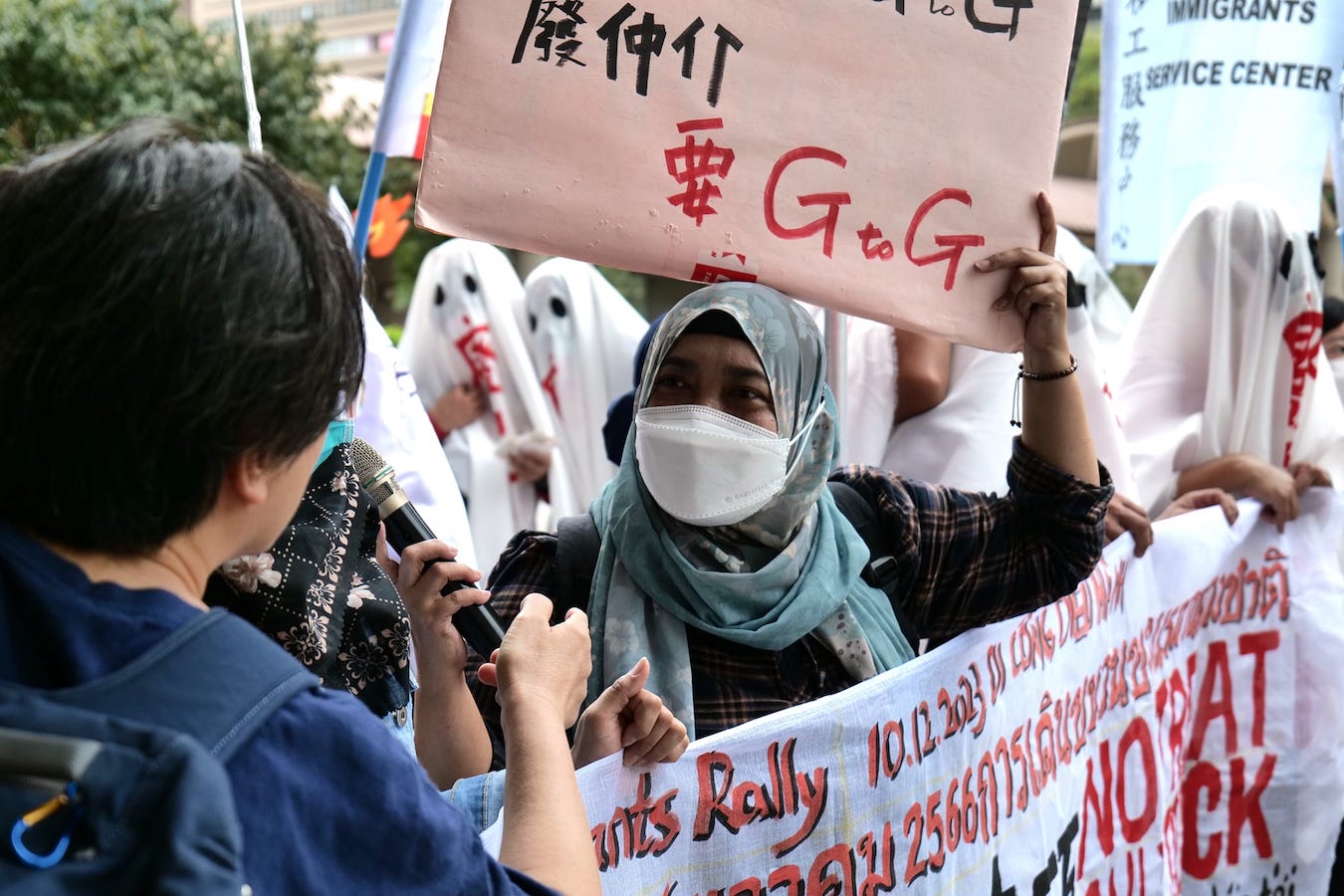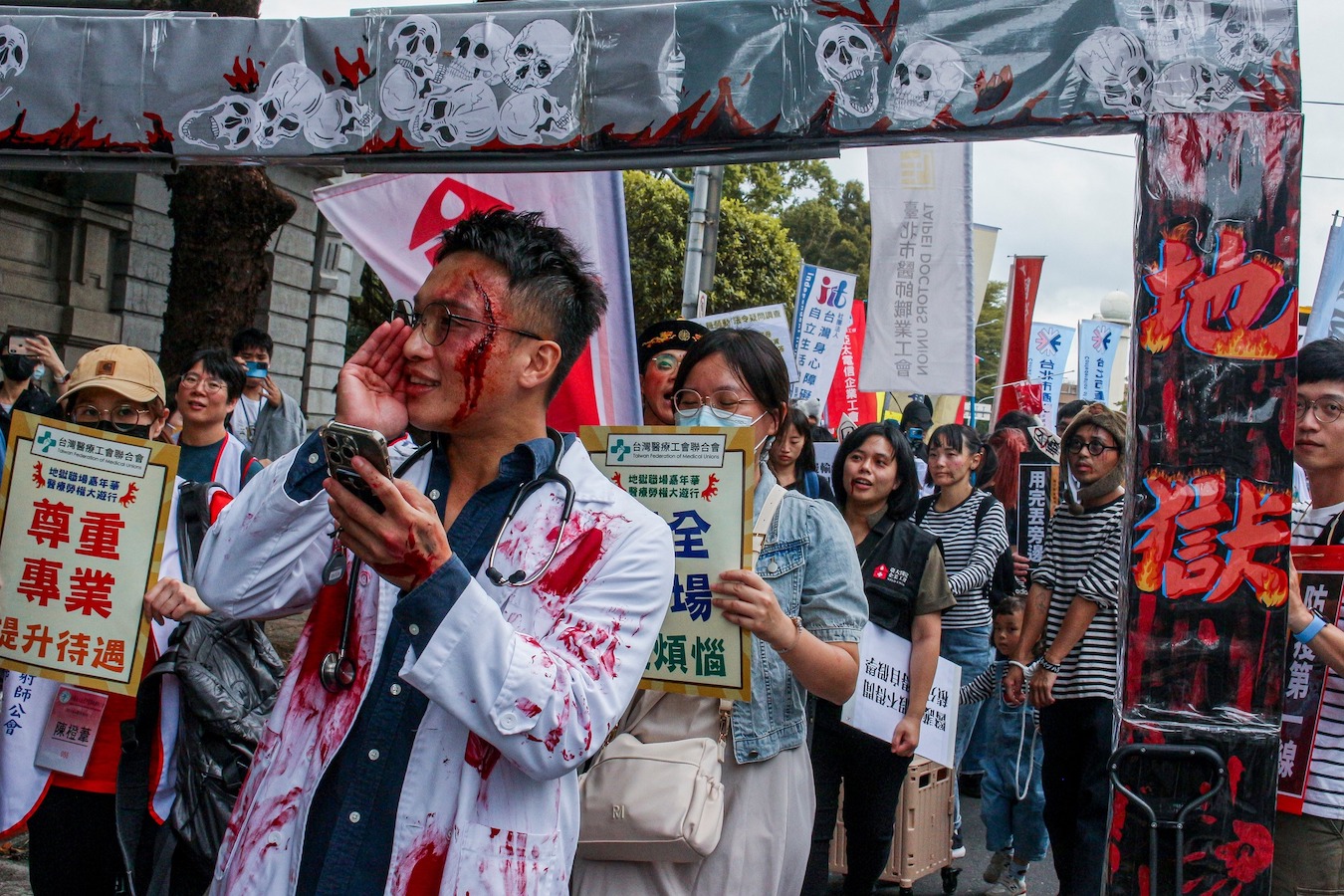by Brian Hioe
語言:
English
Photo Credit: TIWA/Facebook
A NUMBER OF labor protests took place over the last two weeks. As these protests took place in a similar timeframe to Halloween, a number of these demonstrations involved costumes and dressing up.
On Sunday–the one day a week when migrant workers sometimes have off–several dozen migrant workers took part in a demonstration organized by the Migrants Empowerment Network in Taiwan calling for an end to the current broker system. As part of the demonstration, migrant workers dressed as ghosts and chanted slogans about how by way of their working conditions, they had “No treat, only trick.”
Brokers arrange for migrant workers’ employment in Taiwan, as well as their transportation to and from their home countries. Nevertheless, brokers impose exorbitant fees on migrant workers at every step of this process, resulting in migrant workers owing significant fees to brokers. Brokers can also be deceptive about the working conditions migrant workers face in Taiwan. Consequently, migrant workers have long called for the abolition of the broker system, and instead called for direct government-to-government hiring.
 Migrant workers demonstration on October 29th. Photo credit: TIWA/Facebook
Migrant workers demonstration on October 29th. Photo credit: TIWA/Facebook
For its part, the Taiwanese government has continued to maintain that there is a market need for brokers, and defended the broker system. Brokers historically enjoyed close ties to the Taiwanese government, as a position awarded to associates of the government in authoritarian times. Some countries, such as Indonesia, have taken a stance calling for the abolition of the broker system, but this has been resisted by the Taiwanese government.
A similarly theatrical protest was the Halloween-themed demonstration staged by medical workers the Sunday prior. Around 500 medical workers attended, calling attention to how workplace conditions since the start of the COVID-19 pandemic have resulted in the largest departure of nurses in 30 years.
Nurses called for the introduction of a three-shift system, which the government responded to by introducing subsidies for nurses who work overnight shifts. Yet this was criticized as a measure that failed to consult with frontline medical workers themselves, seeing as the burden is sometimes heaviest on nurses who work morning shifts, and the differences in subsidies between shifts can accentuate conflict between nurses. In particular, it is usually younger nurses who work overnight shifts, and the government’s measures were criticized as intensifying generational conflict between nurses.
Last Saturday, daycare workers demonstrated on Ketagalan Boulevard for better working conditions. Organizers claimed that 10,000 participated in the demonstration. The Childcare Policy Alliance, which organized the protest, called for the government to directly intervene in childcare rather than leaving this up to the private sector in such a manner that contributed to the widespread commercialization of childcare services.
 Demonstration by medical workers. Photo credit: 台灣醫療工會聯合會/Facebook
Demonstration by medical workers. Photo credit: 台灣醫療工會聯合會/Facebook
The protest took a stance against private childcare centers, which outnumber publicly-run childcare centers by seven to three. Demonstrators criticized the fees imposed by private childcare centers on parents, as compared to the standardized fees of publicly-run centers, while suggesting that private childcare centers cut corners in order to lower costs.
Lastly, professional drivers’ organizations demonstrated on Monday outside the Legislative Yuan against penalties against drivers of buses, taxis, and trucks. The demonstration was against new regulations rolled out in June that suspend driver’s licenses for two months for drivers who have twelve points in violations and revoke licenses for those who have two suspensions in two years. Drivers’ organizations take the view that this penalizes drivers unfairly and can put them out of a means of livelihood, given difficulties parking in Taiwan due to poor road design, and the large number of scooters. The protest otherwise takes place at a time when there have been increased calls for improving pedestrian safety in Taiwan, with the view that current laws favor cars over pedestrians and that this contributes to pedestrian injuries or fatalities.
The wave of labor protests was likely timed to center demands by various unions ahead of elections in January. Nevertheless, labor rights have not become a significant issue in the current campaign cycle. It is to be seen if this changes in the coming months, perhaps with continued demonstrations by unions.

